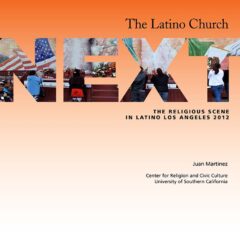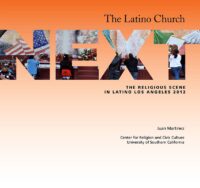There does seem to be a relationship between religious practices and ethnic identity in Los Angeles. Traditionally it has been assumed that there was a relationship between Catholicism and Latino ethnic identity. But the large Pentecostal Latino churches and the large Latino presence in “non-Latino” churches seem to indicate that “pentecostalized” religious practices also support ethnic identity maintenance. It remains to be seen whether this trend will continue or if cultural adaptation to the dominant U.S. culture or secularization will erase Latino ethnic identity. This creates an interesting tension for Latinos.
Is Americanization an inevitable influence that needs to be addressed but cannot be changed? Or should Latinas encourage a strong Latino identity among their children as a way of helping them maintain a strong religious identity (or vice versa)? Can Latinos better contribute to U.S. society, if they resist the negative aspects of Americanization? When people think about Latino religious experience they usually only focus on what happens north of the border, though the Pew study recognizes that “religious affiliation in Latin America is very relevant to any examination of Hispanics in the United States.” But globalization, legal and undocumented migration, and transnationalism are also factors that are changing the U.S. Latina religious landscape. It is important to think about the impact of this movement on religious practices and affiliation both in Latin America and among U.S. Latinas.
There is continued religious devotion among Mexican-Americans to patron saints and virgins of Mexico, particularly the Virgin of Guadalupe. How does this movement reinforce Catholic religious identity even beyond the immigrant generation? How do the people moving in both directions take their faith with them? Do converts remain Protestant if and when they return to Latin America? Popular preachers and religious musicians from Latin America are also very popular among Latino Protestants, reinforcing religious practices from the south. Earlier generations of Latino converts from Los Angeles became informal missionaries among their relatives and friends when they returned to Latin America. Now the movement is in both directions. To what extent are religious tendencies among Latinos in Los Angeles a function of life in the United States and to what extent are they similar to what is happening in Latin America?
The Latina experience in Los Angeles is an ongoing story. Several factors keep the experience from becoming a thing of the past, like the immigrant histories of groups from Europe. The fact that the United States shares a border and a globally unique “borderlands” relationship with Mexico supports ethnic identity maintenance. Continued migration—north and south, both legal and undocumented—has also created a significant mass media in Spanish, largely financed by multinational media interests in Latin America (and the U.S.). Because of the continual need for new workers from Latin America the Latino population will continue to be influenced by the south. All of this makes it unlikely that the Latino experience will ever become exactly like that of the European immigrants of the nineteenth century.
Given that Los Angeles has experimented with several potential ways of bringing together peoples from many backgrounds, it is not surprising that Latinos reflect the gamut of possibilities. Some Latinas have structurally assimilated into an Anglo conformity model. Others celebrate the contribution they bring to the melting pot. And still others reflect on various versions of cultural pluralism and how Latinos are creating something that is American and Latino. Should they develop and maintain their own institutions or should they be part of existing structures? This question is closely linked to the religious question, particularly for Protestants. Should Latino Protestants join existing churches in the United States or form their own? How do one’s views of what “should” happen in the United States parallel or differ from one’s views about what churches should look like? From the time of the U.S. takeover of the southwest both Catholics and Protestants had Americanization as one of their goals for ministry among the new Spanish-speaking citizens.
The U.S. Catholic Church assigned non-Latinos to Latino majority parishes, often removing Mexican priests, and Protestants linked Americanization to their evangelization. Both established schools to encourage Latino children to learn English. During the early years, language was a clear barrier between Latino and Euro-American Christians, and it continued to be with each new wave of immigrants. But as U.S.-born generations learned English this was no longer a barrier. Racial and class barriers still existed, but they were not as clearly marked for Latinos as they were for African Americans. Many Latinos could “pass” if they wanted to and some chose to do so. But leaving the barrio or the rural Latino community also represented the opportunity for success in the United States. The cost of success for most young Latinos was leaving behind a strong ethnic identity. Young Latinos often found that once they went to school and developed a profession they often no longer fit in their former churches. The class difference also meant that they often felt somewhat more comfortable in English-language congregations, though they were not always easily welcomed.
The issue usually becomes complicated with the “second generations,” either literally the children of immigrants, or merely children who are struggling with their own issues of identity. On top of all the other issues related to adolescence in a globalized world, Latina young people also have to deal with the social pressure to leave their “Latinoness” behind. Latino churches have struggled with this issue and have come to different conclusions. Some have assumed that the church should be a place for ethnic identity maintenance. Churches that have taken this perspective are intentional about making sure that programs are in Spanish and that children and young people learn about Latino culture. Others go in the opposite direction, assuming that their children will fully assimilate. They do not directly offer programs for their children and youth, but link those programs to an existing majority-culture sister congregation. A third option is that of adjusting programs depending on the tendencies of the adolescents themselves.
Upward social mobility is also a factor in the religious changes of some Latinos. For some in Los Angeles success is about living in suburbia. A sign of economic success is the ability to purchase a home, usually in a new area. Because they moved for economic benefits they often weaken their social networks, making it easier to think about going to church outside of the Latino community. The idea that Catholicism is a crucial component in maintaining a strong Latino identity continues to be an object of study and debate. Obviously, Latina Protestants have demonstrated that one can be Latina and Protestant. But Catholicism has been a key component in the development of the Spanish language as well as Latin American and Latino culture. This raises several important questions. How linked are Spanish and Catholicism? Are they so deeply connected that anyone who speaks Spanish is reflecting a Catholic worldview, even if they are Protestants? A related question is whether one preserves any real links to latinidad if one is neither a Catholic nor speaks Spanish. What would be the core of a Latino Protestant identity that entails neither Catholicism nor the Spanish language?
Juan Martinez is a former fellow with the USC Center for Religion and Civic Culture.


